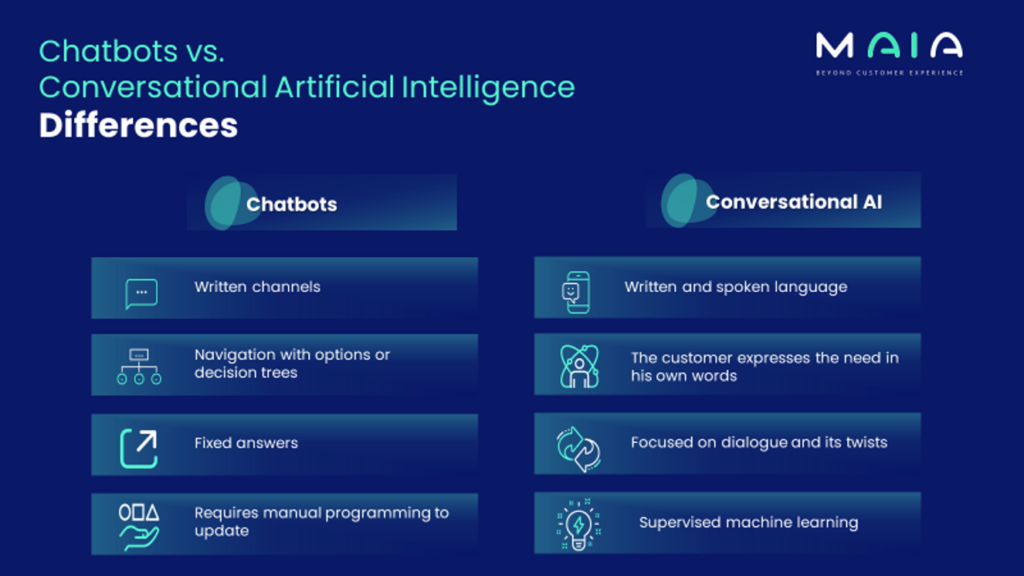In our busy day, we often have to contact our bank, cell phone provider, or even the gym! In addition, we are often short of time, and therefore want to resolve our queries and formalities as quickly as possible.
Before making a phone call, we make use (voluntarily or involuntarily) of chat or messaging applications such as WhatsApp. In this way, companies provide us with the information we need without having to talk or interact with a person, and for this they use “chatbots”.
“Chatbot” is a very common term to name, in a standard way, all the technologies that allow to automate the answers in a chat without the need for human intervention.
So, when we present MAIA as a conversational Artificial Intelligence, it is normal that we encounter the following questions from some customers:

Is a Chatbot the same as a Conversational AI? What are the differences between one and the other?
Let’s start with the most important: No, a Chatbot and a Conversational Artificial Intelligence are not the same, but what is the difference?
Conversational Artificial Intelligences are mainly characterized by capabilities such as:
Speech recognition.
Unlike chatbots, conversational AI’s are designed so that, in addition to processing written language, they can identify spoken language.
Chatbots are usually limited to written channels such as chat or messaging services (WhatsApp, Telegram, etc).
Natural Language Understanding (NLU).
A Conversational Artificial Intelligence, it is able to recognize a customer’s requests when he expresses himself in his own words, so it is open to recognize complex requests. Not everyone says the same thing in the same way. For example.
In the case of chatbots, there is no comprehension capability, the way a customer interacts is through predefined options or a decision tree that guides the conversation through specific topics.
Dialogue management.
Conversational AI’s are dialog-oriented. They manage interactions dynamically. They also have the ability to “remember” what they have discussed in previous requests with a customer, pick up on topics, because they manage the context of the entire conversation.
In contrast, a chatbot manages interactions in a fixed, rule-based way, often guided by menus of options, with no flexibility or ability to go outside the flow. Chatbots, moreover, do not have the ability to remember previous queries to execute or respond to complex requests.
Natural Language Generation (NLG).
A conversational AI responds using human and natural language to customer requests and can adapt to the way of communicating in a given situation. While a chatbot gives predefined answers that do not vary or adapt to the context that the customer may have provided.
Machine Learning (ML).
The use of Machine Learning allows conversational AI to constantly learn from responses, conversation history and user preferences; this allows to personalize responses and user experience. It also allows the quality of responses to constantly evolve because AI learning is parallel to its operation.
Technicians take advantage of all the experience acquired by Conversational AI to teach it what to say in new situations not previously identified.
Chatbots do not learn, their responses are static so they do not allow customizing the user experience; they also need manual programming to keep them updated.

The future… Conversational Artificial Intelligence or Chatbots?
What is certain is that both Chatbots and Conversational AI’s are here to stay.
Both allow companies to automate information processes in marketing, sales and after-sales services, mainly thanks to their ability to provide 24/7 attention.
However, with the recent emergence of Open AI and Chat GPT, and the visibility that is being given to the capabilities provided by Generative AI models, many companies have considered using, or evolving their chatbots, and implementing Conversational AI.
But what is the main reason? It is undoubtedly to provide a better customer experience, more personalized attention and, above all, to attend to more complex processes in an automated way, resulting in significant savings.
Do you have any doubts about why you should choose a Conversational AI?
If so, we’d be happy to talk to you! Shall we talk?
